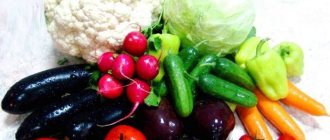Diet for atopic dermatitis: what is its importance?
The skin of a child or adult susceptible to any form of dermatitis suffers from excessive dryness, itching, cracks, peeling, redness, and small blistering rashes filled with exudate. If you scratch damaged areas of the skin, additional symptoms are added to the indicated symptoms: bacteria get into the scratching, which leads to the appearance of wounds and suppuration.
To increase the intervals of remission, it is necessary to follow all the recommendations of the attending physician. These include taking prescribed medications, performing local procedures aimed at improving the protective functions of the skin and restoring its hydrolipid balance, as well as strict adherence to the diet. Nutrition for dermatitis has its own characteristics, which everyone who is susceptible to any skin diseases should know about.
The cause of exacerbation of the disease does not always depend on the consumption of prohibited foods. However, they too often become triggers that cause an undesirable reaction, so the patient should not neglect the diet for skin dermatitis. Its goals are as follows:
- Reducing or completely eliminating allergenic foods from the menu.
- Removing harmful substances from the body.
- Complete provision of the body with vitamins, microelements, proteins, fats and carbohydrates necessary to restore the protective balance of the skin and improve its epithelization.
If the diet of patients with dermatitis does not bring positive results, and periods of remission are reduced, the cause of exacerbations may be caused not by nutrition, but by other factors. To detect them, a full examination is necessary.
Cross-reactivity of some products
What is compatibility and what products are best combined with each other?
Table 3. Product compatibility
| Pasta and potatoes: | Combine with lean meat, boiled or stewed. You can add a little cheese. |
| Dairy products: | We combine kefir or natural yogurt with apples; you can eat it with rye flour bread. |
| Vegetable stew: | They go well with boiled meat; you can bake foods together. |
| Cereals: | We successfully combine them with milk and add a little butter. |
You should not combine cereals with meat, cheese, and pasta with butter; it is better to use olive oil.
Diet for atopic dermatitis in adults: menu
Nutrition for atopic, allergic and other types of dermatitis should be based on avoiding potentially dangerous foods. You will have to exclude the consumption of hot, spicy, smoked, salted, fried foods, sweets, baked goods, seafood, exotic fruits, chips, alcohol, citrus fruits, as well as vegetables, fruits and berries with bright colors.
Preference should be given to lean meats, cereals, seasonal green and white vegetables and fruits, and dried fruits.
As for the cooking method, it is best to steam, bake in the oven or boil.
Products of average allergic risk
Less likely to cause allergies are foods such as:
- Quail eggs, apricots, peaches, pomegranates, various berries (including red currants and cranberries), tomatoes, carrots, beets, legumes, including soybeans, seasonings, corn, buckwheat, potatoes, peas, pork, turkey, red apples, broccoli, oats , barley
When creating a menu for atopic dermatitis, they can be included in the diet in small quantities, carefully monitoring the condition of the skin after each meal. In case of deterioration, it is necessary to note in the food diary which foods caused the reaction in order to exclude them in the future.
Hypoallergenic diet for pregnant and nursing mothers with atopic dermatitis
During breastfeeding, a number of dietary restrictions must be observed. In this case, the risk of the child developing atopic dermatitis is much lower. If the parents have been diagnosed with allergic reactions, bronchial asthma or atopic rhinitis, following a diet for dermatitis in adults (preferably at the stage of preparation for conception) is simply necessary.
A pregnant or breastfeeding woman should avoid the same foods that are prohibited for all adults suffering from an atypical reaction (see above).
Alkali-forming products (70–80%)
Alkali-forming products are products that help maintain the pH of the internal environment of the body at a slightly alkaline level, close to neutral, preventing a shift in acidity towards an acidic environment. It is the acidification of tissues that supports the chronic inflammatory process in the body, including on the skin, according to some scientists, therefore the inclusion of alkali-forming foods in the diet is necessary for atopic dermatitis. The most powerful alkaline foods include:
- Lemons, celery, lettuce, greens, cucumbers, radishes, beets, carrots, avocado, cabbage
Opposite foods, that is, those that cause acidification of tissues and can support chronic inflammation, include meat, especially fatty meats, fermented milk products based on cow's milk, cheeses, baked goods, sweets, chocolate, coffee, black tea, alcoholic products .
Diet for atopic dermatitis in children
The nutrition of children with atopic dermatitis should be both balanced and gentle. Products must be selected depending on the age of the child and taking into account the characteristics of his development.
Breastfed babies under 6 months of age should have enough breast milk. Refusing to breastfeed, explaining such an action by the imaginary allergenicity of mother's milk, is a fundamentally wrong decision. It is this that largely shapes the baby’s immune system, so it is advisable to breastfeed the baby until six months of age.
As the first complementary food for children suffering from dermatitis, it is necessary to choose safe foods. The main requirements for complementary foods are that they are sufficiently nutritious and hypoallergenic. So that the baby’s body can easily adapt to new food, it is recommended to introduce no more than one new product within 7-10 days. Complementary foods are introduced between 4 and 6 months. The first complementary food product can be vegetables or porridge (water or mixture). Next, meat and fruit purees are introduced.
Nutrition for atopic dermatitis in children over one year old is in many ways similar to an adult diet. Below is a summary table of the diet for dermatitis in children, clearly demonstrating which foods are allowed and which are strictly prohibited.
| What needs to be excluded completely? | What foods should you limit? | What products are allowed and healthy? |
|
|
|
It is recommended to completely eliminate salt and sugar during exacerbations of the disease. They should be introduced gradually, in small doses. It is better to avoid using spices when preparing baby food altogether.
To determine which product causes an exacerbation of the disease in a child, it is useful to keep a food diary. Write down the time of meal, its weight or volume, method of preparation and the baby's reaction to food. If the baby is breastfed with the addition of complementary foods, the mother must keep a similar diary: in it she must record her own diet.
Heredity is important!
Although food can be a trigger for eczema flare-ups, it does not cause eczema on its own.
The main reason is considered to be hereditary predisposition. Without it, even the strongest allergens will not affect the condition of the skin. And one more important point: not everyone who has eczema has the same triggers for inflammation. That is, some people should not drink milk; even 2-3 sips may cause an aggravation, but others can consume it in any volume and their skin will not be harmed. Therefore, when creating a menu, it is important to know exactly what your “trigger” foods are and remove them from your diet. Potential food triggers for atopic dermatitis flare-ups are very different from typical food allergens. If among the food allergy provocateurs the “big eight” are in the lead - soy protein, chicken eggs, whole cow's milk, nuts, wheat, shellfish, fish and peanuts, then eczema is more often caused by completely different types of food and compounds from the environment.
How to supplement the treatment of dermatitis, besides diet?
Following the rules of a hypoallergenic diet is very important, but diet alone cannot cope with dermatitis. In order for the patient to recover as quickly as possible, we suggest that you supplement the therapy prescribed by your doctor with the use of La-Cri products.
The regenerating cream contains extracts of string, violet, walnut, bisabolol, panthenol and avocado oil. These components have an anti-inflammatory, antipruritic and softening effect.
Intensive cream is used to soften and moisturize very dry skin. Contains wheat germ, shea and jojoba oils, violet and licorice extracts, bisabolol, allantoin and lecithin.
Cleansing gel is an optimal replacement for conventional cleansers. The composition includes licorice and walnut extracts, hypoallergenic detergent components, avocado and olive oil derivatives.
Alkali-forming products (20–30%)
In general, it is worth saying that almost all fruits, vegetables, herbs, spices, alkaline herbal tea, vegetable juices, whole milk, whey, oatmeal, fresh beans, potatoes with skin, any berries, dates, dried figs, almonds, raisins , prunes, and natural juices are classified as alkali-forming products.
Compliance with these simple recommendations, together with the use of effective topical therapy for atopic dermatitis, will reduce the frequency and severity of exacerbations and improve the general condition of patients.
Clinical researches
The effectiveness, safety and tolerability of La-Cri products have been clinically proven. The products are recommended by the Union of Pediatricians of Russia. During clinical studies, specialists were able to record positive results.
As a result of therapy, the following effects of the La-Cri cream for sensitive skin were noted:
- Reducing itching and irritation;
- Relieving skin redness;
- Moisturizing and gentle skin care.
Sources:
- Bonifazi Ernesto, Differential diagnosis in pediatric dermatology, Panfilov Publishing House, Binom. Knowledge Laboratory, 2014.
- Schneiderman Paul, Grossman Mark, Differential diagnosis in dermatology. Atlas, Binom, 2022.
- Reken Martin, Schaller Martin, Sattler Elke, Burgdorf Walter, Atlas of Dermatology, MEDpress-inform, 2022.
Photos of dermatitis
Photo album on the disease
What is an allergy?
If you ate one tangerine and there was no reaction, but a box of tangerines was sprinkled on it, then, as we said above, this is food intolerance. Histamine liberators worked.
Since a true food allergy does not depend on quantity, there will be a reaction even from one tangerine slice, and such an allergy can be detected by simple allergy tests. There is an exception in the form of cross food allergies, where a seasonal allergy, say an allergy to pollen, can manifest an allergy to citrus fruits.
A good illustration of an allergic reaction and its difference from a pseudo-allergic reaction is shown in Fig. 1
Figure 1 - Classification of allergic reactions according to A.D. Ado, 1978
Food allergies are most often first identified in childhood. Nutritional disorders in women during pregnancy and lactation play a leading role in the formation of food allergies in a child. Provoking factors include:
- early transfer of the child to artificial nutrition,
- improper introduction of complementary foods,
- diseases of the gastrointestinal tract and hepatobiliary system (diseases of the liver and biliary tract),
- irrational approach to child nutrition, deficiency of essential nutrients.
The causes of allergies in adults most often include diseases of the digestive system, microbiota disorders, disturbances in the functioning of enzymatic organs (bilious, pancreatic), disrupted food intake, independent transition to strict eating styles (fruit-eating, fasting, keto, etc.) without approval with a specialist.









